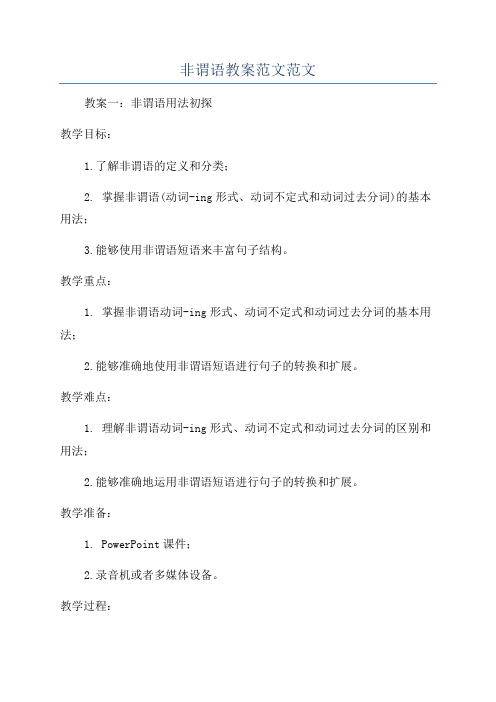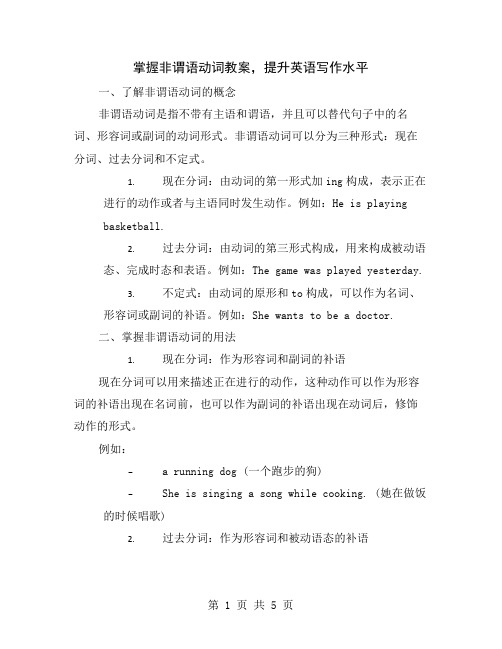非谓语动词教案
(完整版)非谓语动词讲解教案

(完整版)非谓语动词讲解教案非谓语动词讲解教案简介本教案将对非谓语动词进行讲解,包括不定式、动名词和动词-ing形式。
非谓语动词是英语中重要的语法结构,掌握非谓语动词的用法和特点对于提高英语写作和阅读能力十分重要。
目标- 了解非谓语动词的类型和用法;- 能够正确使用不定式、动名词和动词-ing形式。
非谓语动词的分类和用法不定式- 不定式由动词原形前加to构成,如to play、to study;- 不定式常用作动词的宾语、主语、宾语补语等;- 不定式还可与情态动词连用,如can/could/may/might/will/would + 不定式。
动名词- 动名词是动词的-ing形式,如playing、studying;- 动名词常用作名词的主语、宾语、表语等;- 动名词还可与介词连用,如interested in、good at 等。
动词-ing形式- 动词-ing形式是动词的现在分词形式,如playing、studying;- 动词-ing形式可用作现在分词、形容词和副词;- 动词-ing形式还可与一些动词连用,如enjoy/dislike/continue 等。
练请根据下列句子,选择相应的非谓语动词并填空:1. I enjoy ___________ (play/playing) basketball in my free time.2. He didn't remember ___________ (lock/locking) the door when he left.3. She is good at ___________ (dance/dancing).4. They decided ___________ (go/going) to the beach tomorrow.参考答案1. playing2. locking3. dancing4. to go总结通过本教案的学习,我们了解了非谓语动词的不同类型和用法。
完整版非谓语动词教案

目录•非谓语动词概述•不定式的用法与功能•动名词的用法与功能•分词的用法与功能•独立主格结构的用法与功能•非谓语动词的注意事项与误区非谓语动词概述定义与作用定义非谓语动词是指在句子中不充当谓语的动词形式。
它们不受主语的人称和数的限制,具有其他词类的特征,可以充当句子的其他成分。
作用非谓语动词能够丰富句子的表达,使句子结构更加紧凑、简洁。
它们可以表示动作、状态、目的、原因等多种语义关系,增加句子的层次感和表达的准确性。
0102 03形式区别非谓语动词有不定式、动名词和分词三种形式,而谓语动词则根据时态、语态、语气等有不同的形式变化。
功能区别非谓语动词在句子中不能单独作谓语,但可以充当主语、宾语、表语、定语、状语等。
而谓语动词是句子的核心,表示主语的动作或状态。
语义区别非谓语动词可以表示动作的过程、结果、目的等,而谓语动词则主要表示动作或状态本身。
非谓语动词与谓语动词的区别非谓语动词的形式与分类不定式由“to + 动词原形”构成,表示动作的过程或目的。
如:to go, to study 等。
动名词由动词+ing构成,表示动作的过程或状态。
如:walking, studying等。
动名词具有名词的性质,可以充当句子的主语、宾语等。
分词包括现在分词和过去分词两种形式。
现在分词由动词+ing构成,表示主动的动作或状态;过去分词由动词+ed构成(不规则动词有特殊的过去分词形式),表示被动的动作或状态。
分词可以充当句子的定语、状语等。
不定式的用法与功能to + 动词原形,如“to do”。
not to + 动词原形,如“not to do”。
to be + 现在分词,表示正在进行的动作,如“to be doing”。
to have + 过去分词,表示动作已经完成,如“to have done”。
基本形式否定形式进行时形式完成时形式不定式的构成与形式表语不定式短语可以作表语,说明主语的性质、特征或状态,如“My job is to teach English.”。
非谓语动词(教案)

非谓语动词一、教学目标:1. 让学生理解非谓语动词的概念和用法。
2. 培养学生正确运用非谓语动词进行句子构建和表达的能力。
3. 提高学生对英语句子结构的认知和运用能力。
二、教学内容:1. 非谓语动词的定义和分类:动词不定式、动名词和分词。
2. 非谓语动词的用法和功能:作主语、宾语、定语、状语等。
3. 非谓语动词在特定句型中的运用:如“have difficulty (in) doing sth.”,“would like to do sth.”等。
三、教学重点与难点:1. 非谓语动词的分类和用法。
2. 非谓语动词在句子中的功能和位置。
3. 非谓语动词在特定句型中的运用。
四、教学方法:1. 实例分析法:通过具体例句讲解非谓语动词的用法。
2. 练习法:设计各种练习题,让学生巩固所学知识。
3. 互动教学法:引导学生参与课堂讨论,提高课堂氛围。
五、教学步骤:1. 引入非谓语动词的概念,让学生初步了解非谓语动词。
2. 讲解非谓语动词的分类:动词不定式、动名词和分词。
3. 通过例句展示非谓语动词的用法和功能。
4. 分析非谓语动词在句子中的位置和作用。
5. 讲解非谓语动词在特定句型中的运用。
6. 设计练习题,让学生巩固所学知识。
7. 课堂互动:引导学生参与讨论,提高学生对非谓语动词的理解。
8. 总结本节课的主要内容,布置课后作业。
六、教学评价:1. 课后作业:要求学生完成一定数量的练习题,巩固本节课所学知识。
2. 课堂练习:观察学生在课堂练习中的表现,了解他们对非谓语动词的掌握程度。
3. 学生互评:鼓励学生之间相互评价,提高课堂互动。
七、课后作业:1. 请用非谓语动词完成下列句子:a. I (do) my homework every day.b. She (go) to the movies with her friends last night.c. He (have) difficulty (in) understanding the lecture.2. 请用非谓语动词改写下列句子,使其更简洁:a. I saw a interesting movie yesterday.b. She is always late for school.八、教学反思:1. 总结本节课的教学效果,反思教学方法的运用。
非谓语教案范文范文

非谓语教案范文范文教案一:非谓语用法初探教学目标:1.了解非谓语的定义和分类;2. 掌握非谓语(动词-ing形式、动词不定式和动词过去分词)的基本用法;3.能够使用非谓语短语来丰富句子结构。
教学重点:1. 掌握非谓语动词-ing形式、动词不定式和动词过去分词的基本用法;2.能够准确地使用非谓语短语进行句子的转换和扩展。
教学难点:1. 理解非谓语动词-ing形式、动词不定式和动词过去分词的区别和用法;2.能够准确地运用非谓语短语进行句子的转换和扩展。
教学准备:1. PowerPoint课件;2.录音机或者多媒体设备。
教学过程:Step 1: 导入1.教师以小组活动的形式向学生展示一张图片,并提问:“请你们看一看这张图片,它是在描述动作还是状态呢?”2.学生讨论后,教师引导他们注意到图片中所展示的是一个动作。
Step 2: 引入1. 教师向学生解释非谓语的定义:“非谓语是指在句子中展示动作、状态和可能性的词组,它可以是动词-ing形式、动词不定式或者动词过去分词。
”2.教师给出非谓语的分类表格,并讲解其中的几个例子,让学生对非谓语形式产生基本的认识。
Step 3: 学习1. 教师使用PowerPoint课件,给学生呈现非谓语的基本用法和例句。
2.学生跟随教师朗读例句,并尝试回答相应的问题。
Step 4: 操练1.学生以小组为单位进行询问和回答练习,使用非谓语短语来扩展和转换句子。
2.学生根据教师给出的提示,编写一段关于自己周末计划的短文,并在短文中使用非谓语短语。
Step 5:总结1.教师和学生共同总结非谓语的用法和特点;2.学生自主完成一道填空练习,巩固非谓语的用法。
Step 6: 达标检测1.教师对学生进行个别测验,检查他们对非谓语的理解和应用能力;2.学生根据老师给出的句子,完成相应的句子改写。
Step 7: 作业布置1.学生完成课堂上没有完成的练习题;2.学生根据教师的要求,编写一篇关于自己的旅行计划的短文,并在短文中使用非谓语短语。
(非谓语动词)教案

非谓语动词教案一、教学目标1. 让学生理解非谓语动词的概念和用法。
2. 培养学生正确运用非谓语动词进行表达的能力。
3. 提高学生对英语句型的认识和运用。
二、教学内容1. 非谓语动词的定义和分类:动词不定式、动词-ing、动词-ed。
2. 非谓语动词的用法:作主语、作宾语、作表语、作定语、作状语。
3. 非谓语动词在句子中的功能和意义。
三、教学重点与难点1. 重点:非谓语动词的分类、用法和句子功能。
2. 难点:非谓语动词在句子中的辨析和正确运用。
四、教学方法1. 任务型教学法:通过完成各种任务,让学生在实践中学习和运用非谓语动词。
2. 互动式教学法:引导学生参与课堂讨论,提高学生的思维能力和表达能力。
3. 案例分析法:分析典型句子,让学生深入理解非谓语动词的用法。
五、教学步骤1. 引入非谓语动词的概念,让学生初步了解非谓语动词。
2. 讲解非谓语动词的分类和用法,结合实际例子进行说明。
3. 进行课堂练习,让学生运用非谓语动词进行句子创作。
4. 小组讨论,分享非谓语动词的运用心得。
5. 总结非谓语动词的用法和注意事项。
教学评价:1. 课堂参与度:观察学生在课堂上的积极参与程度和表现。
2. 练习完成情况:检查学生完成练习的情况和答案的正确性。
3. 小组讨论:评估学生在讨论中的表达能力和合作精神。
六、教学活动1. 设计不同类型的练习题,让学生在不同情境下运用非谓语动词。
2. 组织小组活动,让学生合作完成非谓语动词相关的任务。
3. 开展非谓语动词的主题写作,提高学生的写作能力。
七、教学资源1. 教材:选取适合学生水平的教材,提供丰富的非谓语动词实例。
2. 课件:制作生动有趣的课件,帮助学生理解和记忆非谓语动词的用法。
3. 网络资源:利用网络资源提供更多的非谓语动词学习资料和实践机会。
八、教学评估1. 课堂问答:通过提问的方式检查学生对非谓语动词的理解和运用能力。
2. 练习批改:定期批改学生的练习,及时纠正错误并提供反馈。
英语非谓语动词教案

英语非谓语动词经典教案一、教学目标1. 让学生掌握非谓语动词的基本概念和用法。
2. 培养学生正确运用非谓语动词表达句子的能力。
3. 提高学生英语写作和口语表达能力。
二、教学内容1. 非谓语动词的分类:动词不定式、动名词、分词。
2. 非谓语动词的用法和句型结构。
3. 非谓语动词在句子中的功能和作用。
三、教学重点与难点1. 非谓语动词的分类和区别。
2. 非谓语动词的固定搭配和用法。
3. 非谓语动词在复杂句子中的运用。
四、教学方法1. 讲授法:讲解非谓语动词的基本概念、用法和句型结构。
2. 案例分析法:分析典型例句,让学生直观地理解非谓语动词的用法。
3. 练习法:设计各种练习题,让学生巩固所学知识。
4. 互动法:鼓励学生积极参与讨论,提高口语表达能力。
五、教学安排1. 第1-2 课时:讲解非谓语动词的基本概念和分类。
2. 第3-4 课时:讲解非谓语动词的用法和句型结构。
3. 第5-6 课时:分析非谓语动词的固定搭配和用法。
4. 第7-8 课时:讲解非谓语动词在复杂句子中的运用。
5. 第9-10 课时:进行课堂练习和答疑。
6. 第11-12 课时:组织学生进行口语表达和实践。
7. 第13-14 课时:总结非谓语动词的重要知识点。
8. 第15 课时:进行课程复习和测试。
六、教学资源1. 教材:英语非谓语动词相关章节。
2. 课件:制作精美课件,辅助讲解非谓语动词的基本概念、用法和句型结构。
3. 练习题:设计各种练习题,包括选择题、填空题、改错题等,让学生巩固所学知识。
4. 视频资源:寻找相关英语非谓语动词的教学视频,供学生课后自主学习。
七、教学过程1. 导入:通过提问方式引导学生回顾谓语动词的相关知识,为新课的学习做好铺垫。
2. 讲解:详细讲解非谓语动词的基本概念、用法和句型结构,结合典型例句进行分析。
3. 互动:鼓励学生积极参与讨论,提问解答学生在学习过程中遇到的问题。
4. 练习:让学生完成练习题,检测对非谓语动词知识的掌握程度。
非谓语动词教案

非谓语动词教案非谓语动词教案一、教学目标:1. 了解什么是非谓语动词;2. 掌握非谓语动词的基本形式和用法;3. 能够正确使用非谓语动词进行句子构成;4. 培养学生对语法规则的运用能力。
二、教学内容:1. 了解非谓语动词的概念;2. 掌握非谓语动词的种类和形式;3. 学习非谓语动词的基本用法;4. 进行非谓语动词的练习。
三、教学步骤:Step 1:引入1. 教师通过图片和实物引入非谓语动词的概念,引发学生的兴趣;2. 教师向学生解释非谓语动词的定义和作用。
Step 2:知识点讲解与示范1. 非谓语动词的种类和形式:动词不定式、动名词、分词(现在分词、过去分词);2. 非谓语动词的基本用法:a. 动词不定式:用作主语、宾语、表语、定语等;b. 动名词:用作主语、宾语、表语等;c. 现在分词:用作定语、状语等;d. 过去分词:用作定语、表语、补语等;3. 教师通过例句和示范向学生讲解非谓语动词的用法;4. 教师设计一些例题,让学生进行翻译和填空练习,巩固非谓语动词的用法。
Step 3:学生练习1. 学生进行口头和书面的练习,完成一些非谓语动词的句子组织;2. 学生进行小组讨论,互相纠正和改正句子中的错误;3. 学生可以相互出题,让同学们进行回答。
Step 4:讲解与总结1. 教师对学生练习中遇到的问题进行解答;2. 教师对非谓语动词的用法进行总结,强调一些易错点和注意事项;3. 教师进行反馈评价,给予学生鼓励和奖励。
四、教学模式:1. 教师示范与学生练习相结合;2. 教师讲解与学生讨论相结合。
五、教学资源:1. 图片和实物;2. 教师PPT;3. 教材课本;4. 纸笔。
六、教学反思:1. 在设计教学活动时需要注意语言简洁明了,因为非谓语动词的概念和用法对学生来说比较抽象;2. 在讲解过程中需要尽量用简单的例子和语言来解释,帮助学生理解;3. 在练习环节中给予学生足够的时间去完成任务,让学生充分发挥自己的动手能力;4. 在总结阶段需要及时梳理和归纳学生的错误,并及时进行纠正和指导。
掌握非谓语动词教案,提升英语写作水平

掌握非谓语动词教案,提升英语写作水平一、了解非谓语动词的概念非谓语动词是指不带有主语和谓语,并且可以替代句子中的名词、形容词或副词的动词形式。
非谓语动词可以分为三种形式:现在分词、过去分词和不定式。
1.现在分词:由动词的第一形式加ing构成,表示正在进行的动作或者与主语同时发生动作。
例如:He is playingbasketball.2.过去分词:由动词的第三形式构成,用来构成被动语态、完成时态和表语。
例如:The game was played yesterday.3.不定式:由动词的原形和to构成,可以作为名词、形容词或副词的补语。
例如:She wants to be a doctor.二、掌握非谓语动词的用法1.现在分词:作为形容词和副词的补语现在分词可以用来描述正在进行的动作,这种动作可以作为形容词的补语出现在名词前,也可以作为副词的补语出现在动词后,修饰动作的形式。
例如:- a running dog (一个跑步的狗)-She is singing a song while cooking. (她在做饭的时候唱歌)2.过去分词:作为形容词和被动语态的补语过去分词可以作为形容词的补语,对名词进行修饰。
过去分词也可以用在被动语态中,表示句子的主语是被动的。
例如:- a broken pencil (一支断掉的铅笔)-The car was repaired by the mechanic. (这辆车被修好了)3.不定式:作为名词、形容词和副词的补语不定式可以用做名词的补语,表示动作的性质或目的;可以用做形容词的补语,表示句子中名词的特征;还可以用做副词的补语,修饰动词或句子的意义。
例如:-To dance is her hobby. (跳舞是她的爱好)-She has a lot of work to do. (她有很多工作要做)-It is important to speak English well. (说好英语很重要)三、练习掌握非谓语动词的使用1.现在分词的使用练习一:1.The _____ house was empty for years.A. paintB. paintedC. paintingD. paints答案:B2.The ______ man was so tired that he fellasleep immediately.A. runningB. ranC. runsD. run答案:A练习二:用现在分词构造形容词的短语。
- 1、下载文档前请自行甄别文档内容的完整性,平台不提供额外的编辑、内容补充、找答案等附加服务。
- 2、"仅部分预览"的文档,不可在线预览部分如存在完整性等问题,可反馈申请退款(可完整预览的文档不适用该条件!)。
- 3、如文档侵犯您的权益,请联系客服反馈,我们会尽快为您处理(人工客服工作时间:9:00-18:30)。
第九章非谓语动词第一、二、三课时一、学情分析非谓语动词在英语学习当中占了很大的比例,而学生时常不能很好地处理该部分知识点,经常分不清是什么是谓语,什么是非谓语,更搞不清楚什么时候该用谓语,什么时候该用非谓语;其中过去分词和现在分词的用法尤为混乱,不能很好地判断何种情况该用现分,何种情况该用过分;非谓语动词的相关练习做得不够多,综合运用能力较低。
二、教学目标1.知识与技能A.了解非谓语的种类及构成;B.学习各种非谓语动词的主要用法;C.能够在语篇中正确完成非谓语动词的相关练习。
2. 过程与方法A.举例法B.演示法C.类比法D.图解法3. 情感态度与价值观A.培养学生的规范语言表达;B.让学生体会语言的灵活多变。
三、教学重、难点1.非谓语动词的种类及其用法;2.语篇中非谓语动词的正确使用;四、渗透法制教育五、教学过程Before class:(先学任务)一、写出你所知道的非谓语动词的结构。
基本类型:1.to do 2.v-ing 4.v-ed二、用所给动词的适当的非谓语形式填空。
1.Having a trip abroad is good for the old couple, but it remains ________ (see) whether they will enjoy it.答案to be seen2.Life is a journey ________ (fill) with hardships, joys and special moments.答案filled3.Nowadays people separate their waste to make it easier for it ________ (reuse).答案to be reused4.________ (try) out different ideas, we are now getting closer to the answer.答案Having tried5.He didn't keep on asking me the time any longer as he had had his watch ________ (repair).答案repairedDuring class:Step1: warming up & lead in1. Check students’ assi gnment and introduce what they will learn in this class.2. Show the sentences and pictures on the PPT.1) To see is to believe.2) The teacher went into the classroom, followed by his students.3) The man sat under the moonlight, missing his hometown.4) Seeing is believing.3. 非谓语动词的种类和基本用法。
Step2: 动词不定式用法一、不定式的语法意义:I heard her sing. (唱和听见同时发生)I expect to come back next Sunday.(“回来”发生在“预计”之后)2.不定式完成式:表示的动作发生在谓语动词表示的动作之前;He pretended to have reviewed his lessons.I am glad to have met you before.3.不定式进行式:表示的动作与谓语动词表示的动作同时发生;She seems to be waiting for somebody.When he came to see me, I happened to be taking a bath.4.不定式完成进行式:表示的动作发生在谓语动词表示的动作之前,并延续到那个时候,可能仍在进行;She is said to have been waiting a novel this year.She seemed to have been working on a difficult maths problem.5.主动语态:一般表示主动的意义,但有时也可以表示被动意义;They began to learn Japanese last winter.Some stars are too far to see.(= to be seen)6.被动语态:表示被动的意义;The composition contest is to be held next month.She is anxious to be invited to the ball.二、不定式的句法功能:1.作主语:一般表示具体的某次动作。
1)不定式作主语时,谓语用单数:To do such things is foolish.2)主系表结构:To see is to believe.3)当主语较长,谓语较短时,常用it做形式主语,将不定式放到谓语的后面。
常用于下列结构中:(1)It is/was +adj.+(of sb.) to do…(如goo d/ kind/ nice/ clever/ foolish/ selfish…)(2)It is +adj.+(for sb.)+to do…(如easy / difficult / hard / / unwise / possible/ necessary…)(3)It is +a/an +名词+ to do...(如a pity/ a shame / a pleasure /one’s duty / an honor …)(4)It takes (sb.) some time / courag e / patience …to do…(5)It requires courage / patience / hard work… to do…2. 作表语:常表示将来的动作或状态。
Her wish is to become a lawyer.3. 作宾语:ask, agree, care, choose, demand, decide, expect, fail, help, hope, learn, manage, offer, plan, prepare, pretend, promise, refuse, want, wish等只能用动词不定式作宾语。
注意:1.某些及物动词可用-ing也可用动词不定式作宾语但意义不同stop/ go on/ remember/ forget/ regret/ try/ mean….2.某些及物动词think, believe, consider, feel, find, make等后常用it作形式宾语。
4.作定语:当不定式的逻辑主语是句子的主语时,要用主动表被动。
Xiao Li is a very nice person to work with.He wants you to be his assistant.The pen is very nice to write.(用主动表被动)5.作状语:表示目的、结果、原因和情况,不定式的逻辑主语通常是全句的主语;To make a living, he had to work from morning to till night. (目的)6. 作宾语补足语:宾语是不定式的逻辑主语,不定式在表示知觉的动词和使役动词后,不用to ,在动词help后to可用可不用。
这些动词有see, hear, feel, watch, notice; have, make, let等。
但如果句子是被动语态,则to不可省略。
He asked me to help him.She usually helped her mother (to) wash clothes on Sundays.7. 同位语: Is this your purpose, to avoid being punished?8. 独立成分: To tell you the truth, I don’t like you.类似的有:to be frank坦率地说,to cut a long story short 长话短说,等等。
三、不定式的其他用法1.“疑问词+不定式”结构,不定式可以和who, whom, whose, what, which, when, how, where, whether等连用,构成动词不定式短语,在句子中起名词作用,可作主语,宾语,表语等成分。
Where to go has not been decided.(主语)We don’t know what to do next.(宾语)2.“形容词+不定式”结构,部分形容词可后接不定式,与句子主语在逻辑上构成主谓关系,这类形容词多是表示思想感情的,如,eager, sure, glad, lucky等。
I am glad to hear the news.She is sorry to have missed the show.3. 不定式的省略:1)表示感觉的动词(see, watch, listen to, look at等)后作宾语补足语时,to可省略;2)使役动词make, let, have后;3)help后可省,可保留,被动语态要保留to; 4)两个不定式并列时,保留第一个,其余省略;5)had better, would rather …than, cannot but, do nothing but等后可省略to.当堂导练一:用括号中动词不定式的适当形式填空。
1.It’s an honour for me __________(ask) to deliver a speech at the meeting.2.We found them ___________ (work) hard all the time.3.I don’t like myself _________(praise) like that.4.She was glad __________(give) a chance to visit this beautiful city.5.I am sorry _______ (keep) you waiting so long.6.This poem is said ________(translate) into English already.7.After graduation he asked ________ (send) to work in the countryside.8.The computer is difficult _________(control).9.She has a slight headache now. She seems _________ (catch)a cold.10.I am going to have the orphan_____________(live) with me soon.11.They did nothing but _______(play)bridge the whole day.12.We failed _______(get) him________(come) to the party.13.What I’d like ________(do) first is _______(read)today’s newspaper.14.Who is ______(blame)?15.The dog ought________(feed) hours ago.16.What he wants is _________(not interrupt)while he is speaking.17.The books are not allowed _________(take)out of the room.18.He preferred to die rather than _________(give) in.References:1.to be asked 2.to be working 3.to be praised 4.to have been given 5.to have kept 6.to have been translated 7.to be sent 8.to control 9.to have caught 10.live 11.play 12.to get, to come 13,to do,(to)read 14.to blame 15.to have been fed 16.not to be interrupted 17.to be taken 18.giveStep3:分词的用法二.分词的形式1)作表语:相当于形容词,表示性质或状态(不同于进行时和被动语态中的分词,其中的分词是谓语的一部分,表示具体的动作)The invention is encouraging.(The machine is working.)She is unmarried.(The window was broken.)2)作定语:单个分词通常作前置定语,有时也可放在后面;分词短语作后置定语,其作用相当于定语从句She told us an exciting story.His spoken English is very good.These are the color TV sets made in Shanghai.3)作状语:表示时间、原因,条件、结果、伴随情况与方式等,有时分词前可用when, while等连词,分词作状语的逻辑主语必须和主句的主语保持一致。
